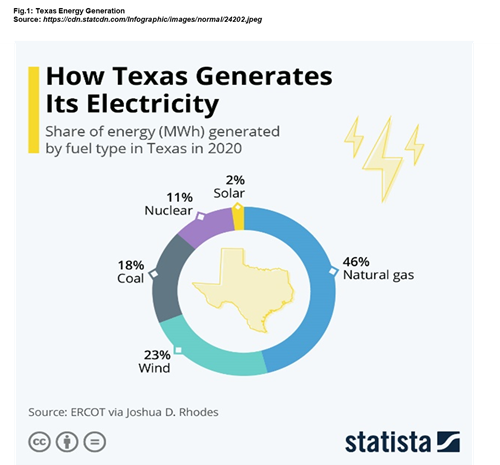It seemed impossible that 2021 would be more “unprecedented” than 2020, and yet many in Texas and across the Gulf Coast are still feeling the impacts of Winter Storm Uri as they survey and recover from damage sustained in Hurricanes Ida and Nicholas.
Although perhaps counterintuitive, these increasingly severe weather patterns – both in summer and winter – are a result of climate change and the global warming trend. According to National Oceanic and Atmospheric Administration stratosphere expert Amy Butler, “…even though you have an overall warming trend, you might see an increase in the severity of individual winter weather events ….” Indeed, the 2022 Old Farmer’s Almanac has already dubbed the coming winter “the Season of Shivers” and notes that “[t]his coming winter could well be one of the longest and coldest…in years.”
So, with all of this extraordinary upheaval, what is to be done? Well, for Texas, it appears that at least part of the solution might be more change: an increased focus on and participation in energy transition initiatives. As executives, politicians, and end-use consumers grapple with issues surrounding energy, the economy, and a feasible and sustainable path forward, Texas continues to dominate the conversation about the impacts of climate change and what role the energy transition could play on a regional, state, and national level. With a robust work force and a unique energy market and political arena, the energy transition could have enormous positive impacts for Texas, the Gulf Coast and the nation.
Current state of the Texas energy market: energy consumption and generation
Everything is bigger in Texas, and that includes energy consumption. Texas is powered by a broad mix of fuels, including: natural gas, coal, motor gasoline, distillate fuel oil, jet fuel, hydrocarbon gas liquids, residual fuel, nuclear electric power, hydroelectric power, biomass and renewables. In terms of energy production, as the largest energy-producing state in the United States, Texas leads the nation in crude oil, wind and natural gas production. Although Texas does generate electricity using a diverse mix of sources, in 2020, the Electric Reliability Council of Texas (ERCOT) recorded that the majority of electricity generation in Texas was still driven by hydrocarbons (natural gas and coal) (see Fig. 1).
But a new day might be dawning for electricity generation in the Lone Star State. In early 2021, ERCOT predicted an increase in natural gas, wind and solar production and a decrease in coal and nuclear production based on operational installed capacity. The impacts of the energy transition nationally and a focus on energy transition initiatives within Texas could further serve as a catalyst to accelerate the evolution of Texas’s energy mix in the coming years and pave the way towards a lower carbon future.
What does the energy transition look like for Texas?
The energy transition’s impact could be a game-changer for both the Texas and national economies.
Houston – arguably, the energy capital of the world – could be pivotal in leading that transition with rapid job creation, increased access to reliable energy, and heavy investment in energy and energy-appurtenant infrastructure.
First and foremost, the energy transition could benefit Texans directly through an explosion of new jobs and economic opportunities for Texans and increased diversification of and more reliable access to energy for end-use consumers. A comprehensive report recently released by 27 labour unions in Texas estimated that the energy transition could create 1.1mn jobs in Texas over the next 25 years. What does that mean for Space City? The Greater Houston Partnership Energy Transition Strategy states that “if Houston were to take decisive action to lead in the energy transition, the region could gain…an additional 400,000 [to] 560,000 jobs.” At the heart of the energy transition is the understanding that existing oil and gas and other integrated energy companies can leverage existing knowledge and infrastructure as they supplement their current business models to embrace the shift towards a lower carbon future. There is great opportunity for Houston, Texas, and the greater Gulf Coast in the near term as the energy industry and the region continue to develop opportunities by repurposing and revitalizing traditional oil and gas infrastructure and deploying the established, skilled workforce in the area through emerging technologies like hydrogen, ammonia, carbon capture, utilization and storage (CCUS) and recycling of plastics.
Additionally, the energy transition could highlight and increase synergies across energy industry participants. Recent trends in energy transactions, particularly in Texas, include (i) an increase in joint venture formation (particularly pairings of clean energy experts and developers with companies that are exploring partnership-based lower-carbon opportunities); (ii) strong acquisition and divestment activity as companies diversify their portfolios and acquire industry players with established experience or innovative technologies; and (iii) growing participation in equity financings by venture capital firms and companies investing in clean tech startups developing breakthrough technologies or projects across the energy transition spectrum.
In particular, the Greater Houston Partnership Energy Transition Strategy focuses on attracting and supporting companies in “New Energy” industries, including encouraging investment into companies (such as those focused on CCUS) and tapping into “sources and financing models ranging from federal government appropriations to venture capital to green bonds.”
Finally, as investment grows in the region, the energy transition could lead to the development of more energy and energy-appurtenant infrastructure projects. This development will include obvious and needed upgrades to existing infrastructure such as roads and transmission lines, but will likely also include innovations in the way Houston’s nearly 2.5mn residents live and work. Energy efficient office buildings, residential complexes, schools and green spaces are already changing the landscape of the Gulf Coast. Infrastructure is the backbone of this country and Houston is uniquely positioned to lead the way towards a more sustainable future with its port, rail, ship channel and air infrastructure.
Fuel for thought: Things to be on the lookout for
Following Winter Storm Uri, which affected more than 4.5mn Texans, the Texas legislature assessed a multitude of proposals and passed bills to address the regulatory landscape within the energy industry. Grid reliability, weatherization, securitization and penalties were the key issues, but the impact of those bills is yet to be seen. What is clear, however, is that increasing reliable access to electricity has broad support across the state.
As Governor Greg Abbott is up for re-election in 2022, there is no doubt that energy will be a key issue on the minds of voting Texans. The outcome of the gubernatorial and other down-ballot elections could impact how the state handles every energy issue, including energy transition initiatives. Through research provided by the University of Texas at Austin, Brookings found that “there is an impressive overlap between where fossil fuel jobs [and hubs] are now and where renewable energy generation could be” with Texas counties making it onto the top 10 lists for the highest wind and solar PV potential. Therefore, Republican districts may benefit economically by embracing a lower carbon economy.
Politics aside, since Texas accounted for 12pc of the total electricity generation in the United States in 2020 Texas’s involvement in the future of the energy landscape is critical. Therefore, all eyes should and will be on the Lone Star State as it navigates one of the greatest opportunities of a generation – the energy transition.
Lindsey Swiger (Senior Associate, Houston) and Geetika Jerath (Associate, Houston) are members of Norton Rose Fulbright’s Projects practice and are Co-Chairs of Norton Rose Fulbright’s US Energy Transition Associate Team.









Comments